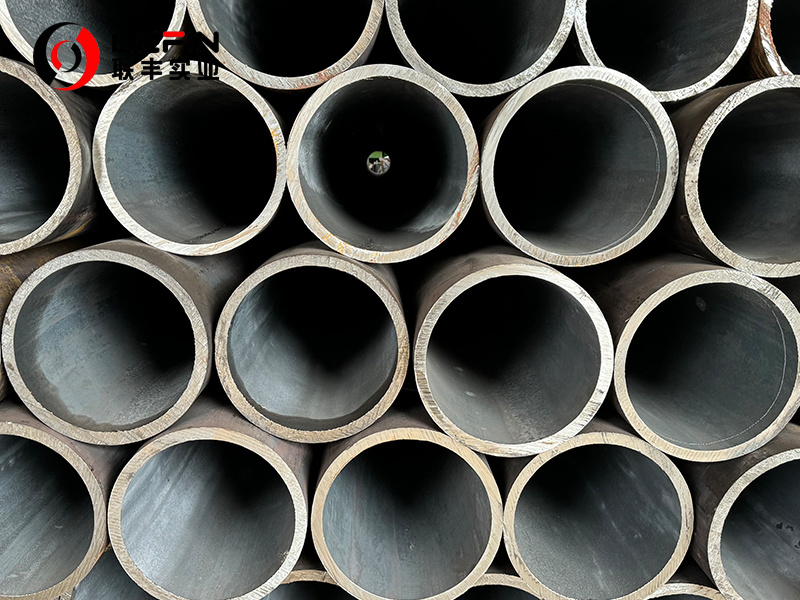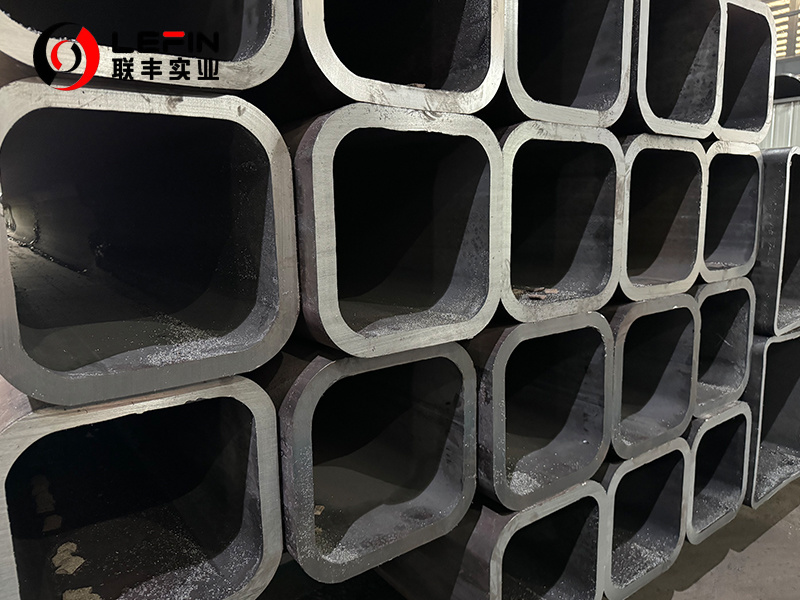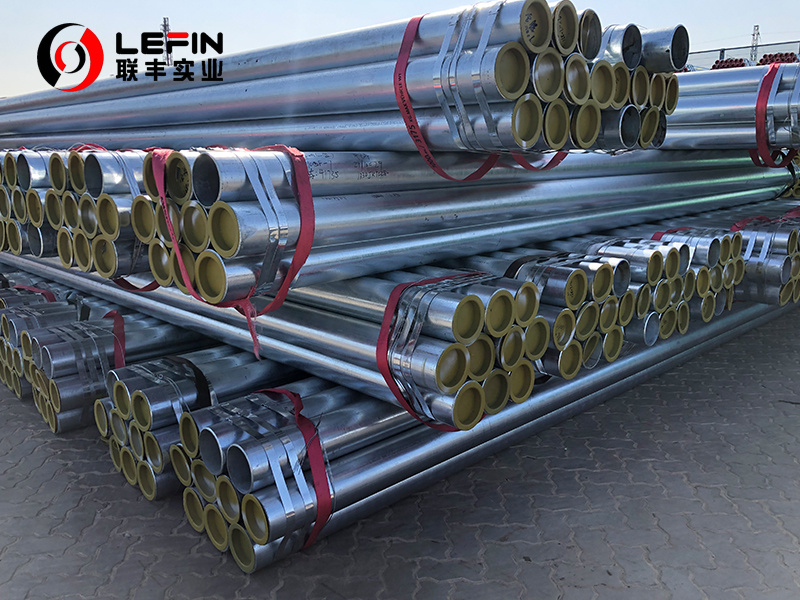





- Details
-
HOT EXPANDED SEAMLESS PIPE
Out diameter: 19.05-114.3mm
Wall thickness: 2-14mm
Length: 3m-10m
Standard: ASTM A53, ASTM A106, API5L, BS, JIS, GB
Material: GR.B, X42, X52
Surface Treatment: black oil coating, galvanized coating, PE

Features of hot expanded seamless pipe
1. Production process:
Thermal expansion seamless steel pipe is the process of expanding the diameter of the pipe by the miter rolling or drawing method. This process can increase the outer diameter of the steel pipe in a relatively short time, and produce non-standard and special types of seamless steel pipes, which has the characteristics of low cost and high production efficiency.
2. Material characteristics:
The thermal expansion steel pipe has the characteristics of relatively low density but strong shrinkage, this steel pipe is completed in a short time with the thickness increase, and can produce non-standard and special types of seamless pipe.
3. Application field:
Thermal expansion seamless steel pipes are widely used in a variety of industries, such as oil and gas, construction, automotive, etc., especially for high temperature and high pressure environments to meet the needs of critical applications.
4. Technical parameters:
The technical parameters of thermal expansion seamless steel pipe include outer diameter, wall thickness, length, etc., according to different standards and application requirements, there can be different sizes and specifications.
5. Advantages:
The main advantage of thermal expansion seamless steel pipe is its ability to complete the product range of both companies and allow for the provision of packaging. Spraying lubricant on the surface of the mandrel can reduce the friction resistance between the mandrel and the steel pipe, reduce the pressure load and power consumption of the rolling mill, extend the service life of the mandrel and improve the rolling quality of the steel pipe.
6. Quality control:
During the production process, the thermal expansion seamless steel pipe will undergo strict quality control, including internal flaw detection, quality inspection and other steps to ensure that the product meets industry standards.
7. Environmental adaptability:
Thermal expansion seamless steel pipe because of its excellent mechanical properties and process properties, can withstand high pressure and impact, especially suitable for use in harsh environments.

What are the advantages of using HOT EXPANDED SEAMLESS PIPE over traditional seamless pipe?
1. Strength and durability:
- The manufacturing process of seamless steel pipes includes heating and mechanical expansion, which enhances the mechanical properties of the pipes, resulting in higher tensile strength and yield strength. This makes them suitable for high pressure applications.
2. Uniform wall thickness:
- The thermal expansion process allows for better control of wall thickness, ensuring uniformity over the entire length of the pipe. This is important to maintain consistent pressure levels and flow characteristics.
3. Corrosion and wear resistance:
- Thermal expansion seamless steel tubes can be manufactured from various grades of steel, including stainless steel and alloy steel, which provide excellent corrosion resistance. This is particularly important in industries where pipes are exposed to harsh chemicals or environments.
4. Versatility:
- Thermal expansion seamless steel tubes can be produced in a variety of sizes, lengths and wall thicknesses, making them suitable for a variety of applications in different industries. The selection of materials and heat treatment processes allows customization to meet specific performance requirements.
5. High temperature and high pressure resistance:
- These pipes are able to withstand high temperatures, making them ideal for use in boilers, heat exchangers and other environments where thermal resistance is key. Due to their robust construction, these pipes can handle high pressures, making them suitable for applications such as oil and gas pipelines, petrochemical processing, and more.
6. Reduce failure risk:
- Seamless construction eliminates the risk of welding defects, such as weaknesses and fatigue failures of welded joints. This enhances the overall safety and reliability of the pipeline system.
7. Reduce maintenance costs:
- The durability and corrosion resistance of heat-expanded seamless steel tubes help extend service life, which significantly reduces maintenance and replacement costs.
8. Improved flow characteristics:
- The manufacturing process usually results in a smooth internal surface that reduces friction and enhances flow characteristics. This is particularly beneficial in fluid transport applications.
9. Quality assurance:
- Thermal expansion seamless steel pipes undergo a rigorous quality control and testing process to ensure that they meet industry standards and customer requirements. This provides a guarantee of its performance and reliability.

How does the manufacturing process of HOT EXPANDED SEAMLESS PIPE differ from that of traditional seamless pipes?
1. Thermal expansion seamless steel pipe manufacturing process:
·Cross rolling: The manufacturing process of thermal expansion seamless steel pipe includes cross rolling, which is a rolling method between longitudinal rolling and cross rolling. Cross rolling is mainly used for pipe perforation and rolling, as well as rolling steel balls with periodic sections.
·Perforation process: The perforation process of thermal expansion seamless steel pipe is more reasonable and automated. The whole cross-rolling piercing process can be divided into three stages: unstable process, stable process and another unstable process.
·Thermal expansion: The manufacturing of thermal expansion seamless steel tubes includes key steps such as heating, expansion and finishing to transform solid billets into high-performance tubes.
2. Traditional seamless steel pipe manufacturing process:·Perforation and rolling: Traditional seamless steel pipes are manufactured through a perforation and rolling process, using solid round billets. After the billet is heated in a rotary furnace, it is perforated by a perforator and then rolled by a floating mandrel mill.
·Heat treatment: After forming and sizing traditional seamless steel pipes, heat treatment is performed to improve their mechanical properties and microstructure.
3. Differences:·Metal flow: The main difference between cross rolling and longitudinal rolling and cross rolling is the flow of metal. In cross rolling, the flow direction of the deformed metal forms an Angle with the movement direction of the deformation tool roll, and the metal rotates around its own axis in addition to moving forward.
·Degree of automation: The perforation process of thermal expansion seamless steel pipes has been automated, while the manufacturing process of traditional seamless steel pipes may involve more manual operations.
·Heat treatment and finishing: The manufacturing process of thermal expansion seamless steel pipes includes additional heat treatment and finishing steps to ensure the mechanical properties and dimensional accuracy of the pipes.
These differences make it possible for thermal expansion seamless steel pipes to have higher performance and efficiency in some applications.

HOT EXPANDED SEAMLESS PIPE
Subcategory
Keyword
- Details
-
HOT EXPANDED SEAMLESS PIPE
Out diameter: 19.05-114.3mm
Wall thickness: 2-14mm
Length: 3m-10m
Standard: ASTM A53, ASTM A106, API5L, BS, JIS, GB
Material: GR.B, X42, X52
Surface Treatment: black oil coating, galvanized coating, PE

Features of hot expanded seamless pipe
1. Production process:
Thermal expansion seamless steel pipe is the process of expanding the diameter of the pipe by the miter rolling or drawing method. This process can increase the outer diameter of the steel pipe in a relatively short time, and produce non-standard and special types of seamless steel pipes, which has the characteristics of low cost and high production efficiency.
2. Material characteristics:
The thermal expansion steel pipe has the characteristics of relatively low density but strong shrinkage, this steel pipe is completed in a short time with the thickness increase, and can produce non-standard and special types of seamless pipe.
3. Application field:
Thermal expansion seamless steel pipes are widely used in a variety of industries, such as oil and gas, construction, automotive, etc., especially for high temperature and high pressure environments to meet the needs of critical applications.
4. Technical parameters:
The technical parameters of thermal expansion seamless steel pipe include outer diameter, wall thickness, length, etc., according to different standards and application requirements, there can be different sizes and specifications.
5. Advantages:
The main advantage of thermal expansion seamless steel pipe is its ability to complete the product range of both companies and allow for the provision of packaging. Spraying lubricant on the surface of the mandrel can reduce the friction resistance between the mandrel and the steel pipe, reduce the pressure load and power consumption of the rolling mill, extend the service life of the mandrel and improve the rolling quality of the steel pipe.
6. Quality control:
During the production process, the thermal expansion seamless steel pipe will undergo strict quality control, including internal flaw detection, quality inspection and other steps to ensure that the product meets industry standards.
7. Environmental adaptability:
Thermal expansion seamless steel pipe because of its excellent mechanical properties and process properties, can withstand high pressure and impact, especially suitable for use in harsh environments.

What are the advantages of using HOT EXPANDED SEAMLESS PIPE over traditional seamless pipe?
1. Strength and durability:
- The manufacturing process of seamless steel pipes includes heating and mechanical expansion, which enhances the mechanical properties of the pipes, resulting in higher tensile strength and yield strength. This makes them suitable for high pressure applications.
2. Uniform wall thickness:
- The thermal expansion process allows for better control of wall thickness, ensuring uniformity over the entire length of the pipe. This is important to maintain consistent pressure levels and flow characteristics.
3. Corrosion and wear resistance:
- Thermal expansion seamless steel tubes can be manufactured from various grades of steel, including stainless steel and alloy steel, which provide excellent corrosion resistance. This is particularly important in industries where pipes are exposed to harsh chemicals or environments.
4. Versatility:
- Thermal expansion seamless steel tubes can be produced in a variety of sizes, lengths and wall thicknesses, making them suitable for a variety of applications in different industries. The selection of materials and heat treatment processes allows customization to meet specific performance requirements.
5. High temperature and high pressure resistance:
- These pipes are able to withstand high temperatures, making them ideal for use in boilers, heat exchangers and other environments where thermal resistance is key. Due to their robust construction, these pipes can handle high pressures, making them suitable for applications such as oil and gas pipelines, petrochemical processing, and more.
6. Reduce failure risk:
- Seamless construction eliminates the risk of welding defects, such as weaknesses and fatigue failures of welded joints. This enhances the overall safety and reliability of the pipeline system.
7. Reduce maintenance costs:
- The durability and corrosion resistance of heat-expanded seamless steel tubes help extend service life, which significantly reduces maintenance and replacement costs.
8. Improved flow characteristics:
- The manufacturing process usually results in a smooth internal surface that reduces friction and enhances flow characteristics. This is particularly beneficial in fluid transport applications.
9. Quality assurance:
- Thermal expansion seamless steel pipes undergo a rigorous quality control and testing process to ensure that they meet industry standards and customer requirements. This provides a guarantee of its performance and reliability.

How does the manufacturing process of HOT EXPANDED SEAMLESS PIPE differ from that of traditional seamless pipes?
1. Thermal expansion seamless steel pipe manufacturing process:
·Cross rolling: The manufacturing process of thermal expansion seamless steel pipe includes cross rolling, which is a rolling method between longitudinal rolling and cross rolling. Cross rolling is mainly used for pipe perforation and rolling, as well as rolling steel balls with periodic sections.
·Perforation process: The perforation process of thermal expansion seamless steel pipe is more reasonable and automated. The whole cross-rolling piercing process can be divided into three stages: unstable process, stable process and another unstable process.
·Thermal expansion: The manufacturing of thermal expansion seamless steel tubes includes key steps such as heating, expansion and finishing to transform solid billets into high-performance tubes.
2. Traditional seamless steel pipe manufacturing process:·Perforation and rolling: Traditional seamless steel pipes are manufactured through a perforation and rolling process, using solid round billets. After the billet is heated in a rotary furnace, it is perforated by a perforator and then rolled by a floating mandrel mill.
·Heat treatment: After forming and sizing traditional seamless steel pipes, heat treatment is performed to improve their mechanical properties and microstructure.
3. Differences:·Metal flow: The main difference between cross rolling and longitudinal rolling and cross rolling is the flow of metal. In cross rolling, the flow direction of the deformed metal forms an Angle with the movement direction of the deformation tool roll, and the metal rotates around its own axis in addition to moving forward.
·Degree of automation: The perforation process of thermal expansion seamless steel pipes has been automated, while the manufacturing process of traditional seamless steel pipes may involve more manual operations.
·Heat treatment and finishing: The manufacturing process of thermal expansion seamless steel pipes includes additional heat treatment and finishing steps to ensure the mechanical properties and dimensional accuracy of the pipes.
These differences make it possible for thermal expansion seamless steel pipes to have higher performance and efficiency in some applications.

Related products
Product Consulting

Address: Hengtai Road,Daqiuzhuang Town,Jinghai County,Tianjin,China
Mob: +8615122229899(whatspp)
Phone: +86 22 58171905
Fax: +86 22 58171902
E-mail:info@lefinsteel.com
Get company updates

Tianjin Lefin Industrial Co.,Ltd. All rights reserved City sub-station SEO www.300.cn

